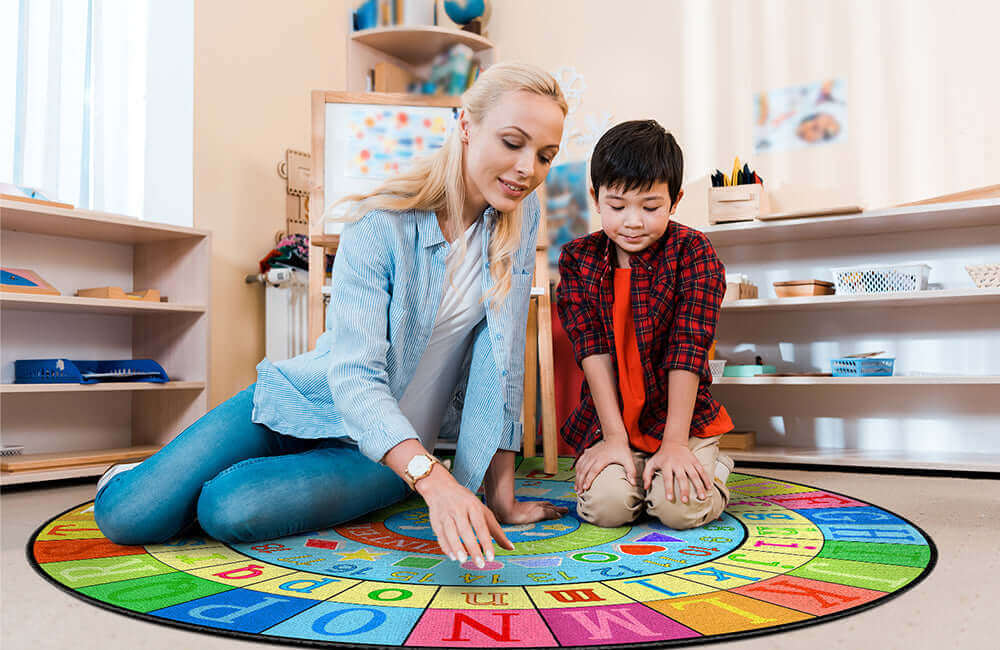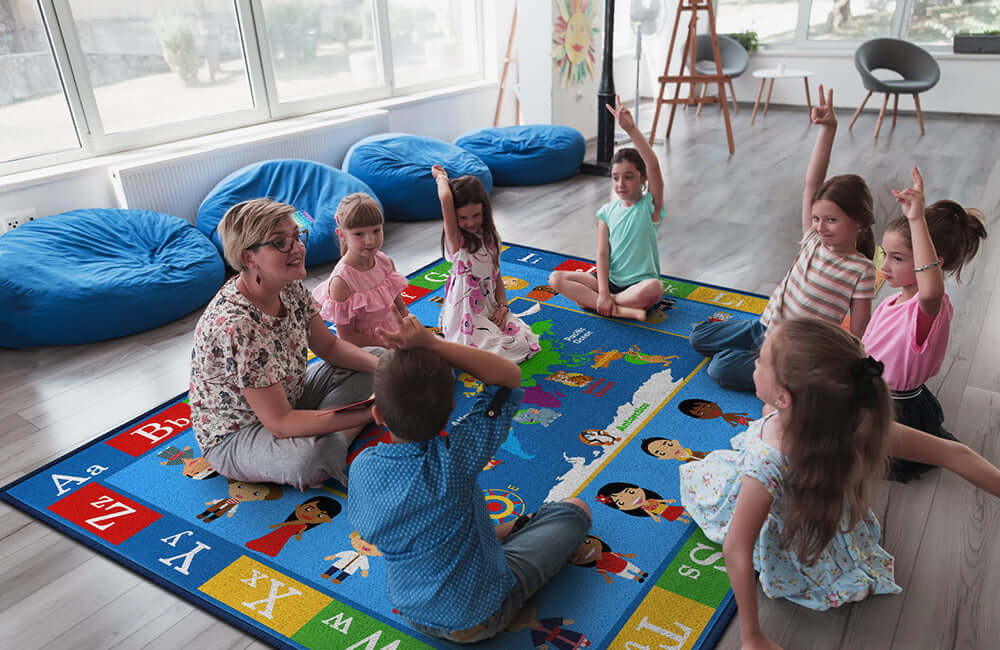Your classroom rugs aren’t just decorative—they’re physical manifestations of your educational philosophy.
Every element, from the arrangement of desks to the organization of materials, communicates your values and approach to teaching and learning.
Among these elements, classroom rugs stand out as particularly powerful statements of intent—especially when chosen from rugs by teaching style collections that align with your instructional approach: they define gathering spaces, create visual anchors, and set the tone for how students engage with the environment and each other.
The relationship between teaching philosophy and physical space is bidirectional.
Your educational approach influences how you set up your classroom, and in turn, your classroom setup reinforces and enables your teaching style.
When these elements align harmoniously, the learning environment itself becomes an active partner in education rather than merely a backdrop.
Why Alignment Matters
Research consistently demonstrates that environmental design significantly impacts learning outcomes.
A study highlighted in Edutopia's article on classroom design found that classroom environments aligned with instructional approaches increased student engagement by up to 45% compared to misaligned spaces.
This alignment matters on multiple levels:
Psychological Congruence
When your physical environment matches your teaching philosophy, it creates psychological congruence that reduces cognitive dissonance for both you and your students.
As noted in Wikipedia's entry on educational psychology, this alignment helps students internalize the norms and expectations of the learning approach.
Operational Efficiency
A rug that supports your teaching style facilitates smoother transitions and more effective implementation of your preferred instructional strategies.
Nonverbal Communication
Your rug choice silently communicates your values to students, colleagues, administrators, and parents who enter your space—reinforcing your educational identity.
Environmental Priming
The design elements you choose "prime" students for the type of learning experiences they'll engage in, preparing their brains for your particular approach to education.
For more on how physical environments influence learning mindsets, visit our article on classroom design psychology.
Traditional Teaching Approaches
Traditional pedagogies emphasize teacher-directed instruction, orderly environments, and structured learning experiences. If your approach leans traditional, consider these rug options:
Key Characteristics
- Clear teacher/student delineation
- Whole-group instruction emphasis
- Structured routines and procedures
- Sequential curriculum delivery
Complementary Rug Choices
- Rectangular seating rugs for classrooms with clearly defined borders
- Solid colors in professional, somewhat formal tones
- Seating-spot rugs with organized, grid-like arrangements
- Simple borders that create visual order
Strategic Placement
Position your rug in front of your main instructional area with clear sightlines to presentation spaces.
The rectangular shape and clear borders reinforce the structured nature of your teaching approach.
"My traditional rectangular rug with individual seating spots has been invaluable for managing my direct instruction periods. Students know exactly where to sit, which eliminates transition time and keeps our academic routines consistent." — Rachel M., 3rd Grade Teacher
According to Education Week, teachers with directive instructional styles benefit from environmental elements that reinforce predictability and clear expectations.
Constructivist Classrooms
Constructivist approaches emphasize student-constructed knowledge and benefit greatly from reading rugs that support peer dialogue and group exploration, inquiry, and collaborative meaning-making. If you embrace constructivist principles, consider these rug options:
Key Characteristics
- Student-directed learning
- Emphasis on questioning and discovery
- Collaborative knowledge construction
- Teacher as facilitator rather than director
Complementary Rug Choices
- Round or organic-shaped rugs that facilitate face-to-face interaction
- Open designs without prescribed seating spots
- Natural colors and textures that inspire curiosity
- World maps or global designs that spark inquiry
Strategic Placement
Center your rug in a way that allows students to gather in a circle or flexible groupings. Avoid positioning that suggests a "front" of the room, reinforcing that knowledge can come from any direction.
"My large circular rug completely transformed our morning discussions. The shape naturally encourages students to respond to each other rather than directing all comments to me, which perfectly supports my constructivist teaching philosophy." — Marcus T., 4th Grade Teacher
For more ideas on creating constructivist-friendly environments, see our guide on inquiry-based classroom design.
Montessori and Reggio Emilia
Montessori and Reggio Emilia approaches emphasize natural materials, beauty, order, and child-directed exploration. If you follow these philosophies, consider these rug options:
Key Characteristics
- Natural, beautiful environments
- Child-scaled elements
- Independence and autonomy
- Respect for the child's rhythm
Complementary Rug Choices
- Natural fiber rugs (wool, cotton, jute)
- Neutral, earth-toned colors
- Simple, beautiful designs without cartoonish elements
- Defined work spaces that support individual concentration
Strategic Placement
Create distinct work areas with Montessori-inspired rugs or mats that define personal work spaces. Use larger gathering rugs sparingly and intentionally for community moments.
According to MindShift's exploration of Reggio-inspired spaces, the aesthetic elements of these educational approaches aren't superficial—they're foundational to the learning philosophy.
For specific product recommendations aligned with these approaches, see our curated collection of Montessori-inspired classroom elements.
Project-Based Learning
Project-based learning environments require flexibility, collaboration, and spaces that can adapt to evolving project needs. If your teaching centers on projects, consider these rug options:
Key Characteristics
- Extended inquiry periods
- Cross-disciplinary integration
- Collaborative teamwork
- Public presentations of learning
Complementary Rug Choices
- Modular classroom rugs that can be reconfigured
- Durable, stain-resistant materials that withstand project work
- Neutral colors that won't compete with project displays
- Multiple smaller rugs rather than one large carpet
Strategic Placement
Create multiple defined areas with large classroom rugs that support various project phases—research zones, creation spaces, and presentation areas.
"We use a system of three different colored rugs to define our project zones—blue for planning, green for creating, and purple for reflecting and presenting. Students move between these areas as their project work evolves, and the visual distinction helps them shift mindsets between different types of work." — Jamie L., 5th Grade PBL Teacher
Social-Emotional Focus
Classrooms that prioritize social-emotional learning need spaces that support community building, emotional expression, and reflective practices. If SEL is central to your teaching, consider these rug options:
Key Characteristics
- Community circle emphasis
- Emotional literacy development
- Conflict resolution practices
- Relationship-building focus
Complementary Rug Choices
- Circular rugs that eliminate hierarchy
- Calming colors like blues, greens, and purples
- Sufficient size for whole-class circles
- Simple designs that don't distract from emotional content
Strategic Placement
Position your circle time rugs in a quiet area with minimal distractions to support community-based SEL practices, creating a dedicated zone for emotional processing and community building.
According to Greater Good Magazine, the physical setup for SEL activities significantly impacts students' willingness to engage in vulnerable discussions.
For more insights on creating spaces that support emotional development, read our article on trauma-sensitive classroom design.
Flexible and Responsive Teaching
Many contemporary educators embrace flexible, responsive approaches that adapt to student needs and interests. If your teaching style is highly adaptive, consider these rug options:
Key Characteristics
- Shifting between different instructional approaches
- Responsive to emerging student interests
- Blend of various pedagogical techniques
- Data-informed instructional decisions
Complementary Rug Choices
- Neutral, versatile designs that work with multiple configurations
- Multiple rugs of different sizes for varying group needs
- Easily movable options (lighter weight or modular pieces)
- Durable materials that withstand frequent rearrangement
Strategic Placement
Create a flexible system where rugs can be repositioned or swapped out depending on your instructional approach for different subjects or learning goals.
As noted in Cult of Pedagogy's examination of flexible classrooms, teachers who successfully implement adaptive environments plan carefully for how physical elements support different types of instruction.
Specialized Content Areas
Subject-specific classrooms benefit from rugs that reinforce content learning and subject identity:
Math Classrooms
- Geometric patterns that illustrate mathematical concepts
- Coordinate plane designs for spatial reasoning
- Number line rugs for younger learners
- Simple designs that don't compete with mathematical thinking
Literacy Spaces
- Comfortable, plush rugs that invite extended reading
- Letter designs for early literacy (used sparingly and intentionally)
- Book-shaped rugs that reinforce literacy identity
- Story circle rugs for read-aloud gatherings
Science Classrooms
- Nature-inspired patterns and colors
- Durable, easy-clean materials for experiments
- Solar system or natural world designs
- Defined zones for different types of scientific inquiry
Arts Classrooms
- Color wheel designs that reinforce color theory
- Highly washable, durable materials
- Creative, asymmetrical shapes
- Bold colors that inspire artistic expression
For content-specific classroom designs across all subject areas, see our comprehensive guide to subject-based learning environments.
Evolving Your Space
As your teaching philosophy evolves, your classroom environment should evolve as well:
Seasonal Refreshes
Consider rotating different rugs seasonally to refresh your space and signal new learning phases to students.
Gradual Transitions
If you're shifting teaching approaches, make incremental changes to your physical environment that support this evolution.
Student Involvement
Invite students to reflect on how the classroom setup supports their learning, gathering insights on what's working and what could be improved.
Documentation and Reflection
Keep a visual journal of your classroom arrangements, noting how different setups influence student engagement and learning outcomes.
As Teacher Magazine notes in their feature on evolving classroom spaces, the most effective learning environments are those that adapt over time in response to observed student needs and teaching goals.
Conclusion
The humble classroom rug, when chosen with intention, becomes much more than a decorative element—it serves as a physical manifestation of your teaching philosophy, silently reinforcing your educational approach every day.
By selecting floor coverings that align with your instructional style, you create visual coherence that supports your teaching practice and helps students understand the type of learning community you're building together.
Whether you're drawn to the structured organization of a traditional rectangular rug, the communal equity of a Montessori-inspired gathering circle, or the flexible adaptability of modular pieces, your choice matters.
The right rug doesn't just cover your floor—it grounds your educational approach in physical reality, creating spaces where your teaching philosophy can flourish.
As you consider your classroom rug selection, remember that the most successful educational environments are those where the physical design and teaching approach work in harmony.
When students walk into a space that visually reinforces what they'll be doing there, they're already halfway to engaging in the learning experience you've planned—before you've spoken a single word.




Leave a comment
This site is protected by hCaptcha and the hCaptcha Privacy Policy and Terms of Service apply.